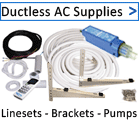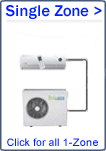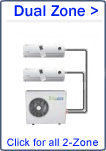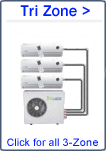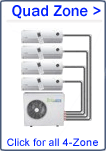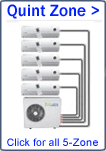How do I Choose a Ductless Split Air Conditioner?
Like all air conditioners, you need to know capacity (BTU's) required to accommodate area you are trying to cool or heat. It is important to remember that Ductless Splits cool - heat a larger area for it's BTU capacity than Portable or Window Air Conditioners. The below BTU key is general guide for gauging coverage areas. Be advised, these capacities are based on standard building conditions. Factors such as insulation, ceiling height and heat load can affect coverage areas.
-
9,000 BTU: 350 - 400 square feet
-
12,000 BTU: 450 - 600 square feet
-
18,000 BTU: 650 - 900 square feet
-
24,000 BTU: 900 - 1150 square feet
-
30,000 BTU: 1200 - 1350 square feet
-
36,000 BTU: 1400 - 1600 square feet
-
48,000 BTU: 1800 - 2400 square feet
-
60,000 BTU: 2500 - 2800 square feet
** SEE BASE OF FAQ FOR NOTE ON NON STANDARD SPACES SUCH AS GROW-GREEN AND SERVER ROOMS. |
| |
Some models are much more expensive than others. Is the extra cost worth it?
Price will vary greatly based on manufacturer, package material and most importantly energy efficiency ratings. Energy efficiency is measured in three values: EER, HSPF and SEER (Seasonal Energy Efficiency Ratio). This means the higher these values, the lower electric cost will be for every hour of operation. However, the higher these values, the more advanced system design and therefore system cost will be more expensive. A 12,000 BTU system rated at 16-SEER can be as low as $600 while a 12,000 BTU system at 23-SEER can be over $1,000. Whether the additional cost is worth it depends on how often you intend to operate system. For example, if purchasing a unit for primary cooling/heating that will be operating year around than additional cost you spend for a higher SEER system can pay itself off in under a year. If you are purchasing for a vacation home, supplemental use or for a rental property where you are not paying for utilities, the cheaper 16-SEER option could be more practical. It is important to recognize that utility, federal, local and state tax rebates are offered for higher SEER products. www.energystar.gov is a good recourse for researching current rebates programs. |
| |
How do I install a mini split air conditioner, do I need a HVAC Professional?
Installing a mini split air conditioner is more advanced than that of a window or portable unit but far less complicated and far less costly than installing central air conditioning system. It is highly recommended that an HVAC professional performs the installation. If you are not sure what you are doing, you will probably end up installing it incorrectly and thereby loose the manufacturer warranty. An HVAC tech will start by doing the basic steps such running the coolant, electricity, and drainage lines, but the qualifications of a professional are most essential when it comes to setting the gauges to charge the lines. (All of our Ductless Splits come pre-charged with R410A for the length of included line set). Click to View our Installation Tip page |
| |
What is the average price for a ductless mini split installation?
Air conditioner installers charge by their time and it is difficult to quote a value as this time will greatly vary on evaporator placement, ease of access and type of building material. 75% of the time that will be spent installing a unit out of box will be drilling holes through the wall and routing copper lineset and wire between indoor and outdoor unit. This is something that can be completed by homeowner though so already having holes drilled and indoor/outdoor units placed will minimize time installer spends on site. See Installation tip. A good rule of thumb for HVAC work is $50 to knock on the door, then $20-$40 / hour for time on site. Installation can take under 2 hours if holes are pre-drilled, single zone mounted evaporator and condenser is placed and as long as all day if we are installing multiple zones, going through complex masonry to evaporators deep inside interior walls. Be sure to verify cooling/heating functions and obtain installer signature on warranty registration prior to signing work order and releasing contractor. |
| |
Do you have anybody you can recommend to install your systems?
We do not have a list of references of nationwide installers for our units. The reason is anybody who is trained in the HVAC - air conditioner industry is more than qualified to complete installation. A local HVAC or EPA license is what is typically required by each manufacturer to comply with warranty. Angie's list and Home advisor are some good places to start researching for prices. |
| |
Iím concerned unit will break shortly after installed. How long do these usually last?
You can expect a life-span of 12-18 years for a correctly installed, well maintained and surge protected ductless system. The most common issues support lines encounter are either refrigeration related (Freon leaks) or wiring mistakes. These can be avoided by paying attention to wiring diagram when connecting indoor to outdoor unit and by ensuring flare connections are securely tightened prior to confirming vacuum step.
In terms of component related failures, control boards are the most common suspect. Inverter system are more like computers than the traditional analog air conditioners. They are built with complex integrated circuits that are very sensitive to electrical spikes and transients. Surge protecting junction box prior to connecting source voltage will minimize these risks.
Pre-mature compressor failures are typically caused by power surges, over/under charging and contamination. These culprits can be minimized further by properly conducting vacuum>evacuation step, ensuring system is properly charged and leak free prior to cycling on and being very careful lineset does not pick up any contaminants when routing through the wall. (leave dust caps on until connection).
There is always possibility of manufacturer defect and no matter what the cause, part will be shipped free of charge if occurs within warranty period and registration is endorsed by licensed HVAC installer.
|
| |
What are the pros and cons of a mini split air conditioner?
| Pros: |
Cons: |
- Less Complicated & Less costly to install than central air
- The noisiest components (compressor fan – condenser motor) are isolated outside freeing indoor space and reducing noise pollution
- The most effective and energy efficient cooling and heating system available.
- Unlike Central Air, gives you the option of specifying which areas to receive the most / least benefit.
- Matches the effectiveness of central air without the expense of retrofitting ductwork.
- Instead of large, bulky exhaust hose, only a small 2-3 inch hole is made in the wall to connect indoor and outdoor units.
|
- More Advanced installation that Window-Portable Air Conditioners
- In most cases, requires an HVAC technician to conduct or complete the final steps of the installation.
- Unit is more expensive than Window or Portable AC's of similar cooling / heating capabilities.
- Considered a Permanent Installation relative to Portable units.
|
|
| |
How big will the hole in my wall be?
Generally, a hole 3" or less in diameter is all that is needed to run the refrigerant and connection lines from the outdoor condenser to the air handler mounted inside. The indoor unit obtains power from outdoor system. DO NOT CONNECT INDOOR UNIT TO BOX. THIS ONLY CONNECTS TO CONDENSER TERMINAL BLOCK. |
| |
How much do they cost to run?
Ductless units provide localized cooling and heating for specified rooms of your home or office, rather than cooling or heating other areas that are not occupied. Since the air is cooled and released directly at the handler and doesn't travel through a duct system, the air does not loose any of it's coolness. This along with the localized climate control enables the ductless-split to operate the most energy efficient cooling system on the market. A 15 SEER efficiency rating is the base industry standard for mini splits - some advanced inverter units will feature SEER ratings in the 20-25 range. |
| |
What does the single - dual - tri zone terminology mean?
Zone refers to how many air-handlers the unit comes with out of box. Our Mini Splits come with either a single zone, dual zone, tri-zone or quad-zone setup. The listed condenser capacity will be divided between the zone outputs in multi-zone systems. For example, a 48000 BTU Dual zone Mini Split will have 2 - 24000 BTU zones. It is most ideal to get an air handler for each room, however, one air handler will be more than sufficient for multiple rooms as long as the total area you are trying to cool is within the limits of the unit's BTU capacity and each space can obtain adequate airflow. |
| |
Can I mount the indoor evaporator on the ceiling instead of a wall?
The most popular and industry standard mini split design is the wall mount which can only be placed horizontally on a wall. However, the ceiling cassette design offers an option that matches the aesthetics of central and duct forced diffusers where evaporator mounts flush into ceiling as long as no restrictions to prohibit placement. It is important to recognize cassettes are more expensive and not all ceilings can accommodate them. Most 12000-18000 BTU cassette options are designed to be recessed between standard 2 ft. off center ceiling beams.
Another option is the ceiling suspended / floor type which hangs from ceiling stud or can mount vertically standing upright on floor. Not all system brands offer these customization options. |
| |
What is the operating temperature range of the unit?
All current stocked air conditioners are Inverter range which means they have ambient temperature ranges from 5° - 109° Fahrenheit. However, it is important to remember that a heat pump may struggle to keep up with demand once outdoor temps drop below 30°. If you live in extreme cold weather climates, you may want to consider an supplemental heat source such as space heating to assist system during extreme times. |
| |
Do the systems come with installation kits?
Many of our package systems come with an installation line set, copper piping and other accessories required for installation. It is important to check the listing details to see if your system comes with these accessories. A multi-zone system where the sets are included will come with an installation kit for each air handler. For example, a tri-zone system come with 3 install kits. The length can be anywhere from 13' to 25' per run for our pre-packages where sets are included. The piping can be extended by purchasing additional piping - flares - couplers etc. on our accessories page or any local plumbing supply store. We also stock additional 15' & 25' lengths if you want to splice 2 line sets together to form longer runs. |
| |
Do the systems come pre-charged?
Yes, all of our mini split systems come pre-charged with eneough R410A refrigerant for the length of the included lineset (usually 25 feet). If the distance between the outdoor compressor and indoor air handler is longer than 25 feet, your HVAC installer will need to add additional freon at time of installation. This is usually between .2 - .25oz for each additional ft above precharge length. Standing pressure should be between 140-180 PSI. |
| |
Why are multi-zone systems sometimes more expensive than matching capacity output with independent single zone systems?
Single zone 9000, 12000, 18000 & 24000 BTU is what we consider our "universal capacities." This means these system sizes are manufactured in such large numbers, price is driven considerably lower than the more niche Dual, Tri, Quad and Quint-zone packages. It is important to factor SEER and Energy Star eligibility when comparing system options. For example, three single 18000 BTU / 16-SEER systems will cost under $3000 while the tri-zone (18000 BTU x 3) package will cost close to $4000. However, the tri-zone option will definately have higher SEER, EER and HSPF ratings than the 16-SEER 18000 BTU systems. Besides long-term energy savings, higher energy efficiency also means higher probability for energy star qualification and tax rebates. |
| |
What is a condensation pump? Will I need one?
All evaporators (indoor unit) removes moisture from the air as part of the cooling process. If the indoor unit is mounted on an exterior wall (meaning opposite of wall is the outside) or the indoor unit is within 8ft of where moisture will be draining, you will most likely not need a condensation pump. The indoor wall mounted type air handler is a gravity drain meaning if the condensation line is short or channeled on a downward slope, then it will not have a problem expelling the moisture. These can always be installed post installation.
There are two types of pump options. The first more expensive option is a micro-mini pump. These are compact enough to fit within the evaporator head. The 2nd cheaper option is the standard type which will have to be placed somewhere outside the chassis of evaporator such as in drywall or line hide duct. The pumps can be powered by either running your own independent electric line from box or splicing into the hot legs feeding the indoor unit. See our Supplies and Accessories page for our condenstate pump options. |
| |
What is best option for green house or grow room applications?
With recent changes in cannabis legislation, ductless mini splits have become a popular solution for the heat generated by light output with green houses and grow rooms. For these spaces, we do not use the standard BTU - coverage area chart at top of this FAQ. Instead, we focus on how many BTU's we need to compensate for heat load generated by lights. A good rule of thumb we use is 6,000 BTU's will be required for every 1000W of non-air cooled lighting and 3,500 BTU's for air cooled lighting. So if we have a 150 square foot space that is running 5 x 1000W of non-air cooled lighting (5KW), we will require 30,000 - 36,000 BTU's.
It is also important to note that going with multi-zone units that provides multiple outputs of air flow will result in higher system cost and higher installation costs as opposed to single head systems. We require capacity for these spaces and don't need airflow or independent zones. Same applies for server or data centers. |
|
|
|



